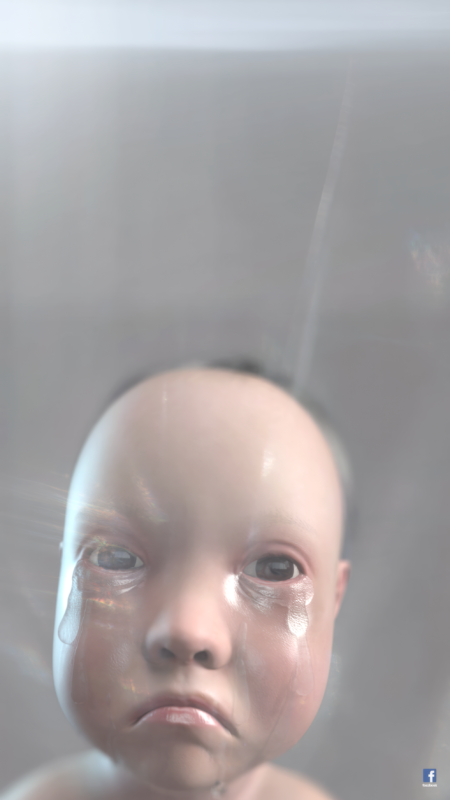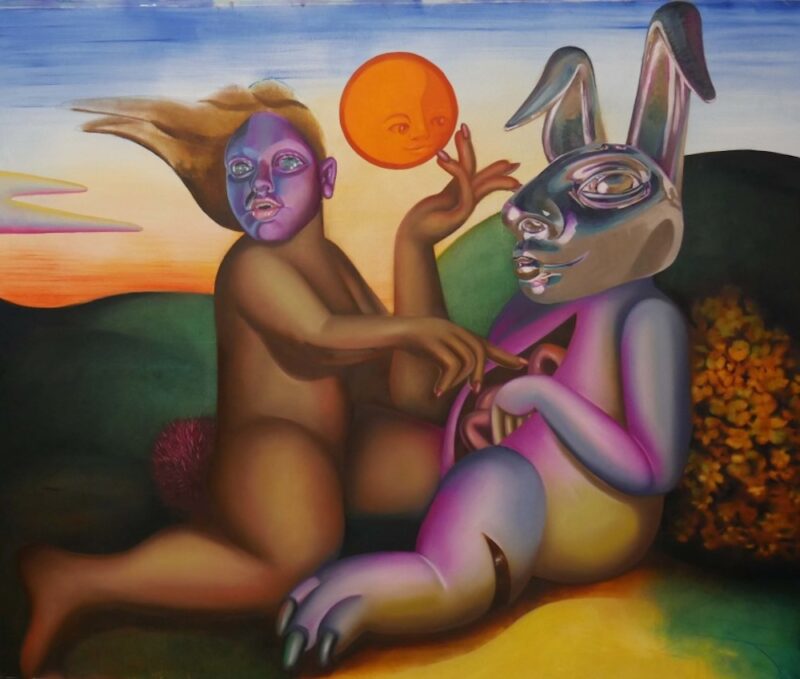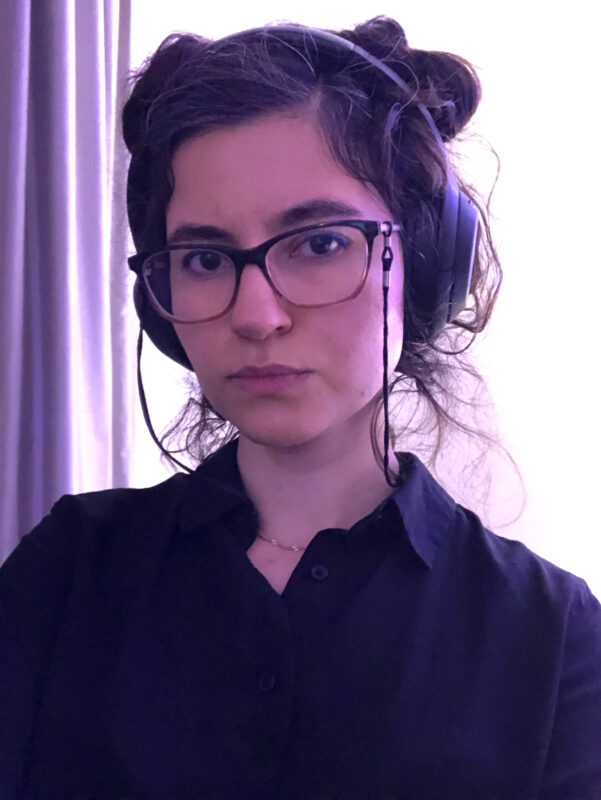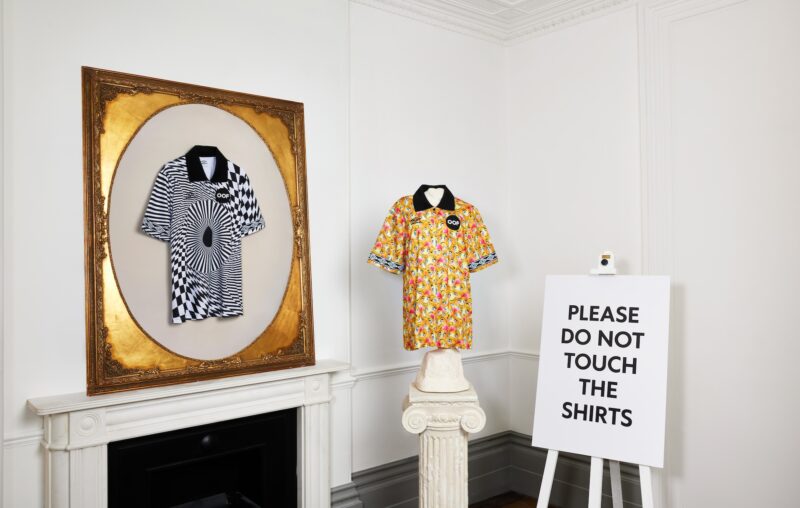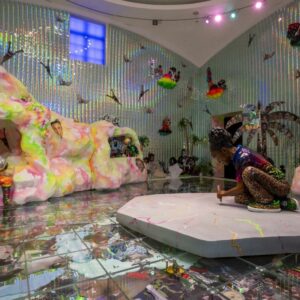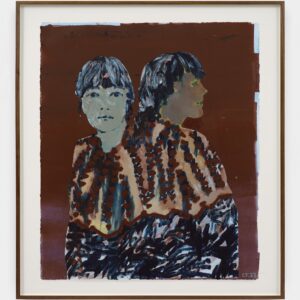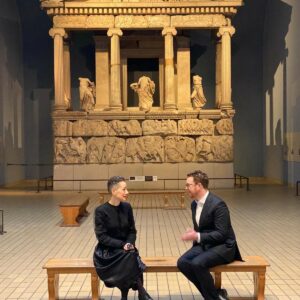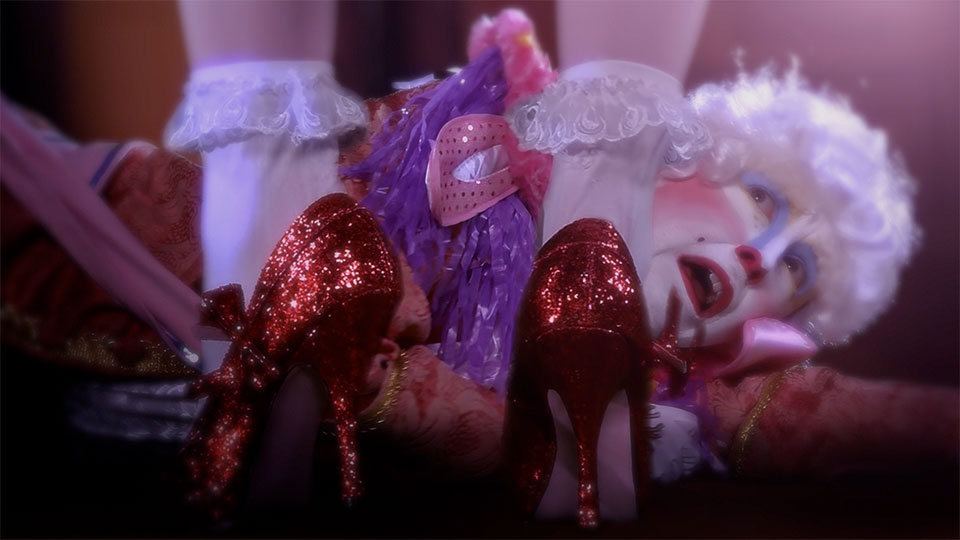
Still from ‘Over the Rainbow’. Courtesy Rachel Maclean.
By Yvette Greslé
Film London and Channel 4 in association with the Whitechapel Gallery have shortlisted 10 Uk-based artists for the Film London Jarman Award. Rachel Maclean (b.1987, Edinburgh) is on the shortlist www.rachelmaclean.com. The winner will be announced next Wednesday 6 November 2013, at Whitechapel Gallery. In anticipation of the Award, film screenings profiling the shortlisted artists will take place at Whitechapel Gallery over the weekend 2-3 November www.whitechapelgallery.org.
Maclean’s films stage hyped up mash-ups of themes and figures from a number of sources. These include the Teletubbies universe of children’s television, infomercials, and horror films. Her characters, which she performs herself, are often exaggerated versions of television and film roles manufactured for women: from glamorous screen goddesses in soft-focus to television advertising’s paranoid germ-killing housewives. Her performances suggest an extraordinary ability to grasp the malleability of identity and characterisation. Digital technology allows for different characters to be played out simultaneously by Maclean, and exchanges and events, both funny and sinister, unfold between apparently disparate actors. Sound is an important aspect of the work: we hear the sultry American-accented voiceovers of perfume advertising or the unmistakable tones of Queen Elizabeth II. Colour is taken to kitsch extremes reminiscent of Disney or the advent of Technicolor MGM musicals: scenes are often illuminated by a surreal, dream-like glow.

Still from ‘The Lion and the Unicorn. Courtesy Rachel Maclean.
Visual worlds are constructed with an intense attention to detail in Maclean’s films: costume, make-up, props, lighting, and set design is all meticulously staged, and all pushed to deliberately exaggerated extremes. The meanings produced by the technical aspects of film-making such as camera angles are astutely observed, and parodied: such as the intimate close-up of product advertising. Moving collages, digitally constructed, insert performances within highly constructed landscapes and interiors that suggest the environments of animated film. Maclean has a keen sense of visual images, their conventions and their histories: she toys humorously with familiar visual symbols such as the theatrical mask. The histories and uses of this well-known prop collide in her work: there are references to eighteenth century masquerades; the disguises of horror film serial killers; or logos on branded products. Hilariously the mask is also quite literally the beauty product at the centre of a Maclean infomercial.
Scottish National identity is a recurring theme in Maclean’s work, and brings a political underpinning to the work; not politics in a didactic sense but rather one that places national narratives and images under scrutiny. Historical figures such as Mary Queen of Scots meet the kitschy symbols of national tourism, reductive hold-alls for national identity.
Maclean’s dense, visually rich practice speaks as much to the history of cinema and popular culture as it does to the history of art. Hybrids of the visual (hyped up to the extreme) and all delivered with exaggerated humour (parody and the grotesque come to mind) prompt us to think carefully about how we relate to images in the 21st century. Our proximity to the screen from mobile technology to laptop is unprecedented; the internet is a resource of infinite visual possibilities and juxtapositions, offering labyrinthine access to images across disciplinary boundaries, simultaneously and at any given time. Technological innovations offer limitless access to how images might be re-imagined and recast. Maclean’s films are visual-aural spaces of extreme sensation that speak powerfully to 21st century screen culture.

Still from ‘Germs’. Courtesy Rachel Maclean.
Interview with Rachel Maclean
Were you nominated for the Jarman Award for a particular film?
I sent in two works: ‘The Lion and the Unicorn’ and ‘Lolcats’.
How do you go about constructing your otherworldly images?
The majority of my work with film is shot on Green Screen, which allows me to create a kind of video-collage. Green Screen gives me the potential to play a number of different characters; and actually have them all on screen at the same time. I can cut figures out, place them on backgrounds, and create these conversations. You can invent these quite surreal, otherworldly backgrounds.
Sound is appropriated from a number of different sources?
All of the audio I use is clips taken from TV and films, which I edit together. During the actual shooting it’s just me miming the character for the audio.
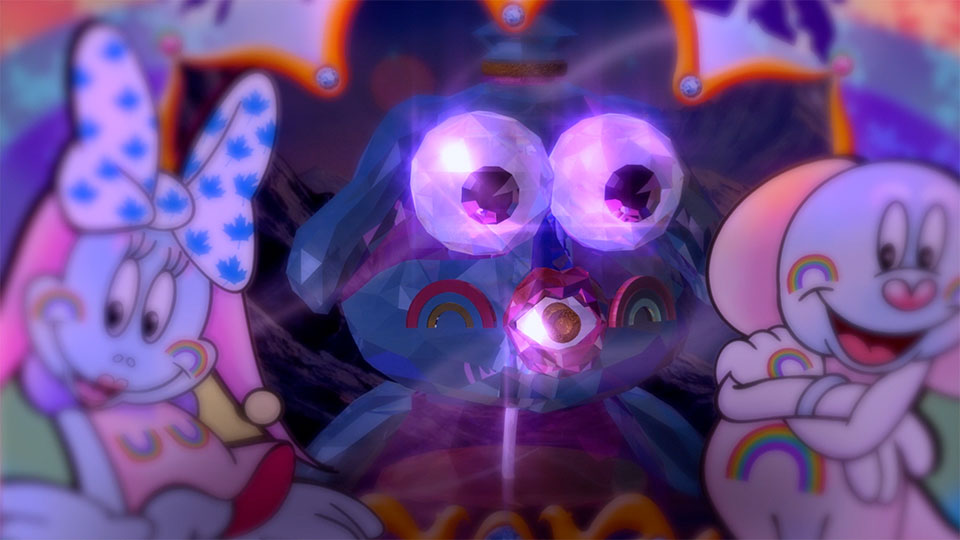
Still from ‘Over the Rainbow’. Courtesy of Rachel Maclean.
The objects you use, your props and backgrounds, often look as though they come from children’s television characters.
I start by making props and costumes. A lot of the materials I use are Poundland toys and kitschy coloured plastics which I put together to make up costumes, and backgrounds. In some videos I’ve taken photographs of toys and then just enlarged them to make backgrounds. I put things together on Photoshop.
The way you describe the process makes me think about set design for film or stage design for theatre, but on a miniature scale. You seem to have this private little world filled with all these props that you find, and you then appropriate and reconfigure them into sets for performances.
That’s what’s quite attractive about Green Screen in a sense. You can do things quite simply that would otherwise have required quite a large, physical set. I make everything miniature so that I can create sets for my characters and props on Photoshop.
Your characters are really strong. You play with different kinds of female roles from cinema history, and powerful cultural signifiers like hair. A lot of them are blonde?
One of the first videos I made, when I was at college, was based on Britney Spears: ‘Hit me Baby’. I was interested in female identity and the way it’s constructed. There is this narrative of her being this sexy school girl (innocent but sexy). Then she becomes pregnant and suddenly is victimised, has a mental breakdown, shaves her hair off. There is this collapse, and a breakdown of her identity. The symbol of hair, and blonde hair, even in fairy tales is very powerful. The idea of long blonde hair which is shaved off is very interesting in terms of identity.
There are so many references to female figures and tropes like the housewife and the domestic goddess. I’m thinking of the parody of Nigella Lawson in ‘Hit me Baby’; and of how these images of women are so much a part of the history of cinema or 1950s adverts but are also absorbed into 21st century celebrity and image culture. It feels in many of your films as though time collapses: the 1950s and the 21st century for instance.
I was thinking about ideas to do with representations of older women. And also representations of women as children: with Britney Spears her image was shattered by pregnancy and growing up. Nigella Lawson’s image seems to be a very old-fashioned notion of what it means to be a woman. It’s very domestic and her image draws on all the stereotypical tropes of the 1950s. She’s the housewife, quite sexy but, at the same time, quite understated in her sexiness.
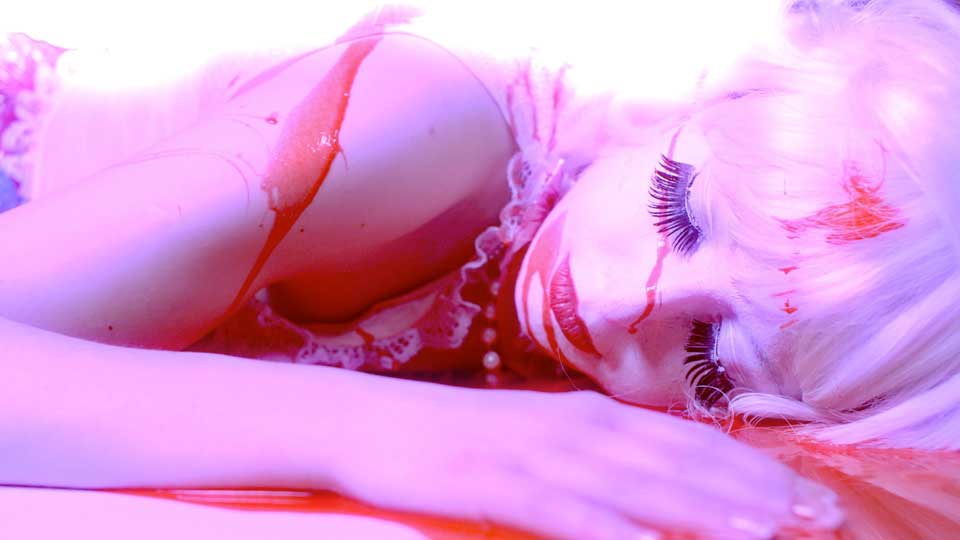
Still from ‘Germs’. Courtesy Rachel Maclean.
You also work a lot with wigs and masks. You seem particularly interested in the idea of worlds that are visibly constructed, and in the idea of illusion. Performance is clearly something that interests you a lot.
I like to take a particular costume and stereotype and really push it to the extreme, and complicate it a bit. I’m interested in characters that are not like real life characters, they’re sealed in these video worlds where they’re hyper-real. They never quite have a skin to them, they’re never quite real. The idea of exploring identity as a performance, as a costume, is interesting to me.
You also explore notions of National Identity in Scotland?
More recently I’ve been looking at national identity. There’s so much talk in Scotland at the moment of Independence. How it relates to cultural identity and national identity. My most recent show was ‘I HEART SCOTLAND’ at Edinburgh Printmakers. I was invited to make work around Scotland’s Referendum. I did a series of prints and showed the video ‘The Lion and the Unicorn’. There’s so much in the debate around independence. Generally speaking in politics, there are ideas that are very binary: you have your position and you fight for it. There’s not much discussion of a middle ground or a gray area. I think that sense of a political discussion being between two camps obscures a lot of the gray areas in-between.
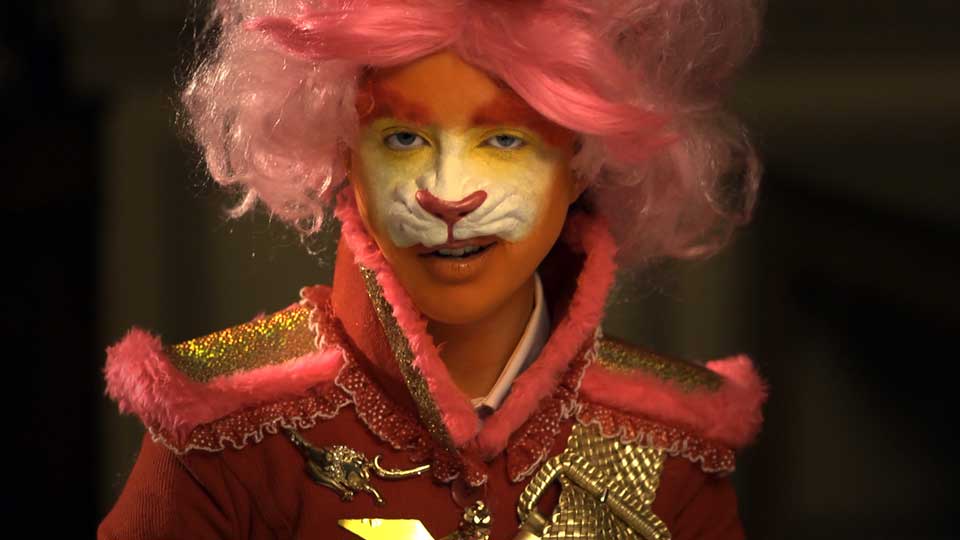
Still from ‘The Lion and the Unicorn’. Courtesy Rachel Maclean.
I think in some ways I was quite keen to deal with some of the oddities within Scottish National Identity. Or a conception of history, which in many ways is quite selective and a semi-fictional reading. I looked closely at some of the stereotypes and things that are used as signifiers of nationalism. I played with myths, and very exaggerated notions about the oppression of Scotland by England. I was also interested in referencing historical painting in the prints I made for ‘I HEART SCOTLAND’. I explored St George and the Dragon except that the dragon is the Loch Ness Monster! I also looked at the relationship of Scottish people to landscape and the idea that it’s an important part of what it means to be Scottish. Scottish landscape is so linked to the Romantic Movement, and ideas about rugged Scottish landscapes. I made a series of four images that are also on a golf course: referencing the Donald Trump golf course.
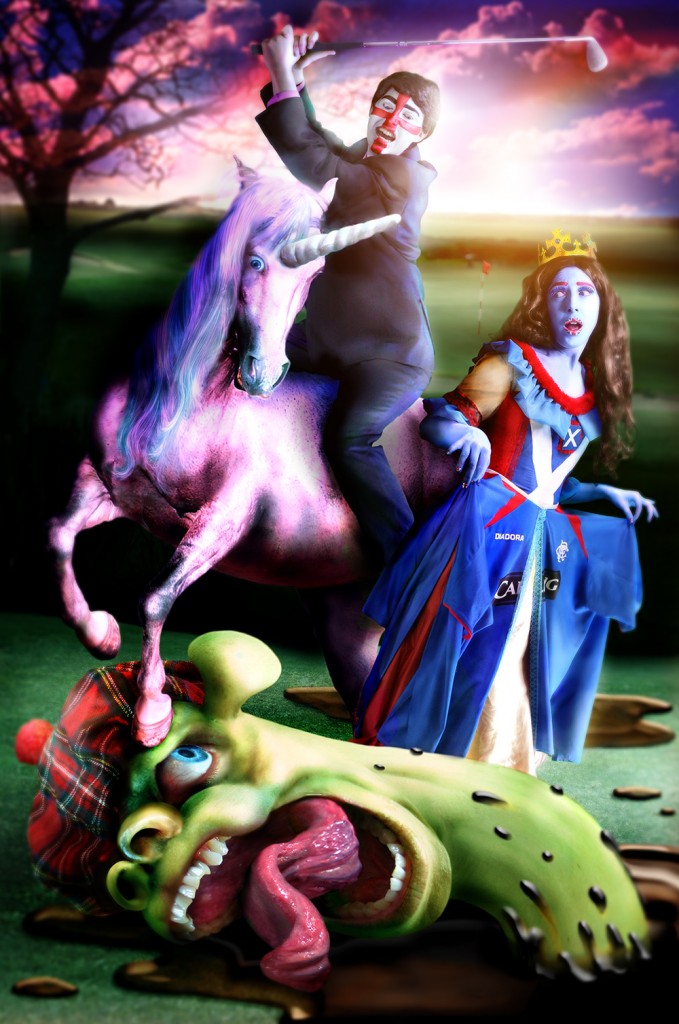
From the exhibition ‘I HEART SCOTLAND’ at Edinburgh Printmakers in August 2013. Courtesy Rachel Maclean.
The absurd is very much part of your work, and parody if you call it that? You really hype things up, you use exaggeration a lot. You take things that we know in the world, and then you reconfigure them, and juxtapose them, and mash them up. I’m interested in what humour does for you as an artist – it’s obviously something that functions as a critical strategy.
There’s some work that seems almost too surreal for people to cope with. But then so many Disney films have cats talking and these narratives played out by animals. Fairly surreal things happen but they seem quite acceptable and conventional. I think it doesn’t take much to take something that’s assumed to be normal and then push it to a point where it seems weird.
In ‘Germs’ there are infomercials, references to horror films and so on. You play with advertising aimed at women using the face mask and parody the obsession with youth. You hype up all the anxieties that television advertising feeds, from germs to female beauty.
When I was in America I noticed that people were obsessed with these sprays for your hands that eliminate germs. There was this sense of germs being all around you, and having to eliminate them. The psychology of that was interesting to me, the idea of preventing things from entering your personal space.
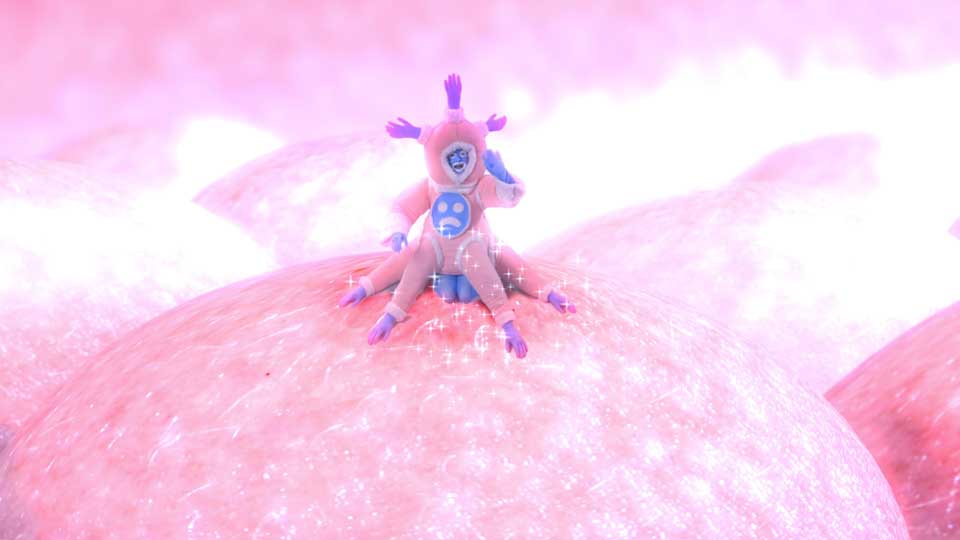
Still from ‘Germs’. Courtesy Rachel Maclean.
Advertising is something that seems to be very interesting to you. Germs are such a major part of advertising discourse.
I’ve looked at quite a lot of toilet adverts. Many of them use an authoritative, almost military voiceover. It’s always a clipped British accent. The germ might have a Cockney accent. There are all these dodgy social connotations. ‘Germs’ was commissioned by Bold Yin’ Ltd ( a Comedy production company in Glasgow). So I guess I approached it more as comedy.
You also play a lot with American accents.
When I was at college, I went on an exchange to America (to the School of the Museum of Fine Arts, Boston). I came back and I don’t think up until then I’d been fully aware of being Scottish. Over there people were quite obsessed with what it means to be Scottish and with kilts and castles and things. I became very aware, especially living in Edinburgh, of tourist culture and the visual culture of that. There was a sense of it as a visual culture you really couldn’t touch. It was made quite explicit at college that it wasn’t the subject of art, that it was this kitschy thing.
Kitsch is an important part of your work.
I grew up at the time that ‘Braveheart’ came out. I remember such an influx of tourists near where I live and an obsession with ‘Braveheart’. They put up a statue of William Wallace which looked exactly like Mel Gibson. There was a sense of Scottish culture being represented by Hollywood, and Scottish culture with an American accent (in films like ‘Brigadoon’). It’s Scotland as a mad fantasy/fairy-tale.
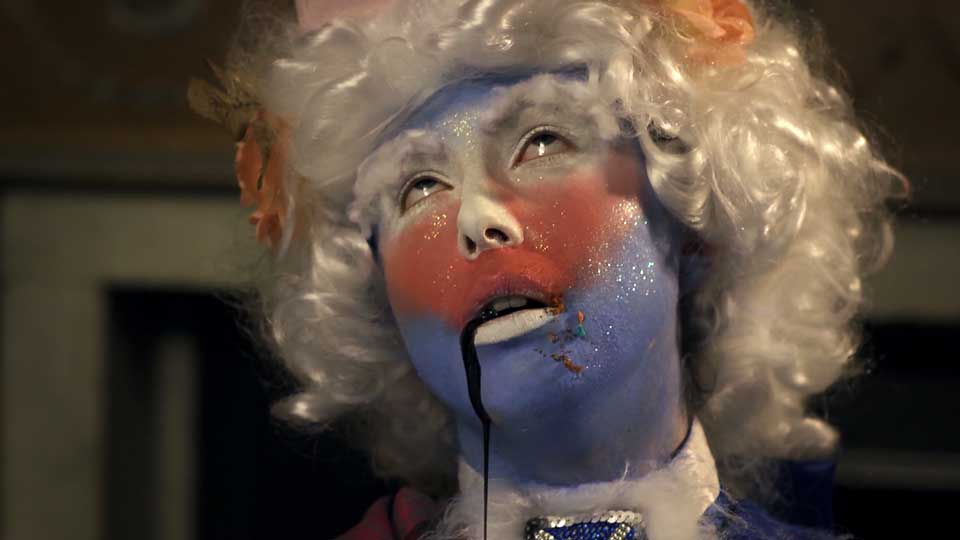
Still from ‘The Lion and the Unicorn’. Courtesy Rachel Maclean.
Images to do with Death come up a lot in your work – I’m thinking of your video ‘I Dreamed a Dream’. Images of skulls are associated with so much, in popular culture as well as in art history. It’s there from fashion trends influenced by rock music to Vanitas paintings and everyday objects associated with Memento Mori.
I’ve always been interested in the grotesque. I’ve looked quite a lot at eighteenth century caricature and ideas about Memento Mori – the idea that death is always waiting for you. I also looked at hourglasses and general symbolism around death. All of this seems to have been phased out of culture now (to a certain extent). I was invited by Polarcap to respond to contemporary Heavy Metal Culture and made ‘I Dreamed a Dream’. There is so much performance, costume and absurdity to Metal and Rock music. Susan Boyle was also quite big at the time on the back of her ‘Britain’s Got Talent’ performance. I was quite keen to play with all of this.
What are the things that visually grip you as an artist?
I’m drawn to making very dense images and work: where there is a lot going on at once. There is dialogue and costume, and props that bring a sculptural idea to the work. There are a lot of themes that run through the work. I like different things playing off one another. Colour also interests me. Each video I make has quite a specific range of colours, and a particular use of colour. In Scotland the legacy of Reformation is a Protestant culture that dislikes colour and finds it difficult to take things seriously if they are colourful. I’m very aware of this in Scottish art and visual culture: it’s very drained of colour.
It’s fascinating to think about all the significations of colour and its cultural significance. Your images are so dense, everything is packed in and there’s nothing sombre or dour about them. Are there any artists in particular that you’re drawn to through history?
An obvious example would be Cindy Sherman. There was something that appealed to me about her work when I was at College. The idea of dressing up and becoming these different characters. I’m interested at looking at identity and costume as a performance. And in playing out these different characters. I look at a lot of Renaissance art. Works like Hieronymus Bosch and ‘The Garden of Earthly Delights’; and Northern European Renaissance Art generally. The grotesque is a major interest. Something that I’m quite keen to do with at least some of my work is to present something that is quite saccharine, cute or benign and then give it an overlay of something that is grotesque. I like to play between these two things so that something quite benign is made to become sinister. With a lot of Renaissance art there was a fascination with imagining hell, heaven doesn’t present the same artistic possibilities!
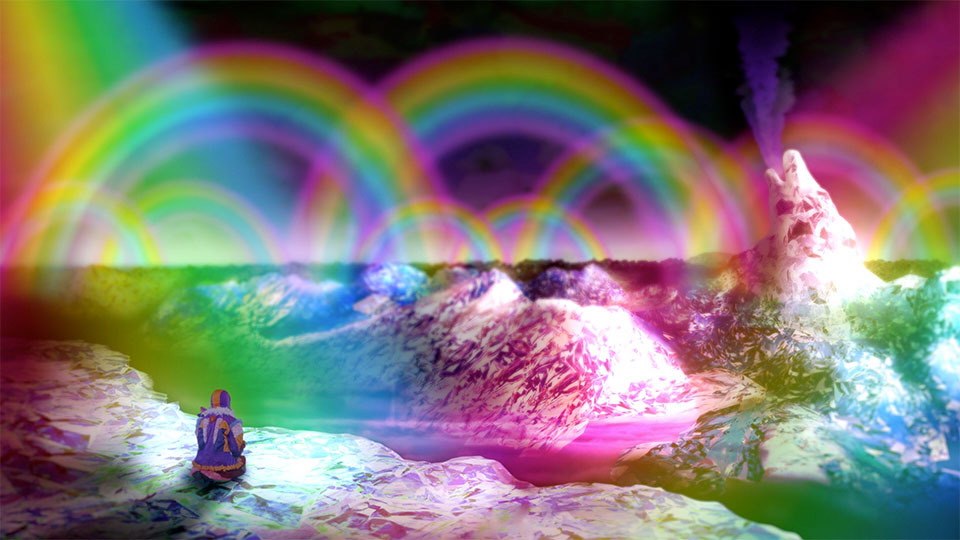
Still from ‘Over the Rainbow’. Courtesy Rachel Maclean.
The relationship between the real, unreal and the hyper-real really seems to interest you. So much of our time is spent with our computers or mobile phone and there are so many worlds that we have access to. You can go from a 1950s film clip on YouTube to CNN to an infomercial.
I’m quite keen on heightened, otherworldly spaces. I’m interested in fairy-tales and legends and how these otherworldly spaces which sit outside of time can develop and refer very specifically to a particular social or political moment. Fairy-tales have developed and evolved to reference something very specific. I’ve been looking at the ‘Arabian Nights’ and Disney’s ‘Aladdin’. ‘Aladdin’ was made just after the first Gulf War and set in Baghdad and it seems to have a relationship to that, a kind of re-reading. Fantasy and Sci-Fi films offer the possibility of reading the contemporary world through this other world – and actually deals more explicitly with ideas of racism, war or politics.
What are you finding interesting at the moment as an artist?
I’m working on a film at the moment. I got an award earlier this year – a Margaret Tait Award. This is given to an artist every year to make a film for the Glasgow Film Festival. Next year is being built up as this big year in Scotland: there’s the Commonwealth Games in Glasgow but also the Referendum. I’ve started to look at the idea of the Commonwealth games and the Commonwealth and what that means, also British-ness and British Identity, and the relationship of the Union of Scotland and England to Empire. I want to create an immersive world which looks like the ruins of a civilisation. It’s still a work in progress.
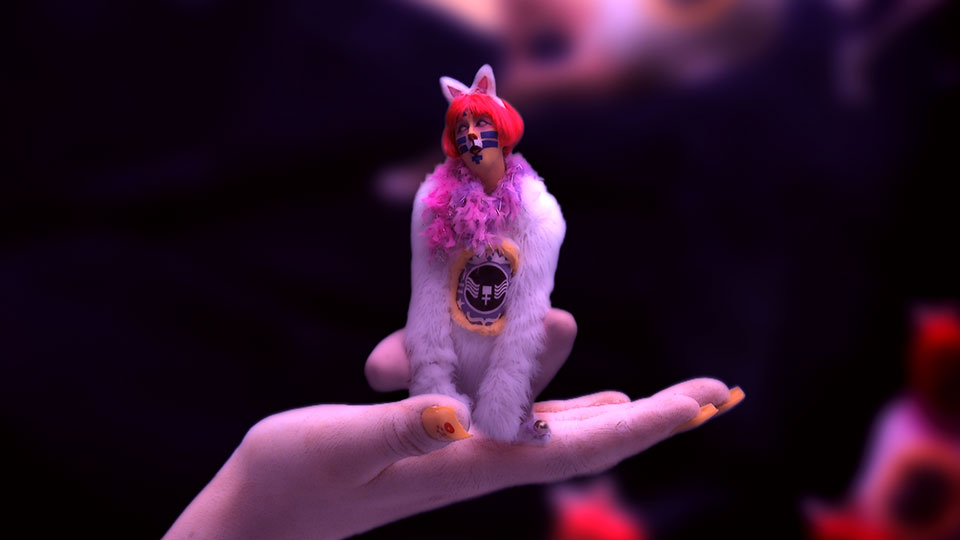
Still from ‘Lolcats’. Courtesy Rachel Maclean.
The Film London Jarman Award winner will be announced next Wednesday 6 November 2013 at Whitechapel Gallery. Film screenings take place at Whitechapel this weekend, 2-3 November www.whitechapelgallery.org
The shortlist for The Film London Jarman Award includes Ed Atkins, Beatrice Gibson, Emma Hart, Uriel Orlow, Charlotte Prodger, Hanna Sawtell, Grace Schwindt, John Smith and Jessica Warboys. The winner will be announced at a special event on Wednesday 6 November at the Whitechapel Gallery, receiving combined prize money of £10,000 and a film commission for Channel 4’s short-form arts strand, Random Acts. This is an especially important year for The Film London Jarman Award Award as it immediately precedes the 20th year commemorations in 2014 of Derek Jarman’s death, which will include the publication of new books and see the artist and his work celebrated through a number of exhibitions and screening programmes nationwide. Previous winners of the Film London Jarman Award are Luke Fowler (2008), Lindsay Seers (2009), Emily Wardill (2010), Anya Kirschner & David Panos (2011), and James Richards (2012).
Three further artists will also be selected for Random Acts commissions, worth £16,000 in total. This is the only Award of its kind where an artist is rewarded with both financial assistance to enable them to flourish and the exceptional opportunity to broadcast their work on national television. Nominated by experts across the UK contemporary film and arts sectors, the shortlist presents the work of 10 artists who use the film and video medium in a range of diverse and uncompromising ways. It offers a comprehensive survey of the work and practice of UK based film and video artists, and celebrates the rich and eclectic array of work emerging in recent years.

Still from ‘Lolcats’. Courtesy Rachel Maclean.
